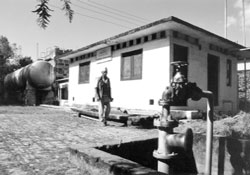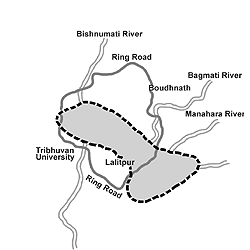 Binita Sharma used to think that vegetables were all that grew on her tiny backyard on the banks of the Bagmati in Teku. Then she found out she was sitting on top of a huge deposit of natural gas.
Binita Sharma used to think that vegetables were all that grew on her tiny backyard on the banks of the Bagmati in Teku. Then she found out she was sitting on top of a huge deposit of natural gas. For the past twenty years, Sharma's family hasn't used firewood, kerosene or cylinders, the household's entire energy requirement is met by a seemingly inexhaustible (and totally free) source of fuel: underground natural gas.
"I have been using the gas to cook," says Sharma, who was at first reticent to talk to media about the bonanza below her feet because she thought the government might start taxing her. The Sharmas were drilling for water when they accidentally discovered gas-a careless plumber lit a cigarette and threw away the match. "The workmen had drilled to about 700 ft when a huge jet of water gushed out of the ground," recalls Sharma. "When the plumber's match touched the ground, it burst into flames."
Geologists have long known that there are huge reserves of natural gas below layers of sediments in Kathmandu Valley-remains of the vegetation and aquatic plans that thrived on the lake bed. They say there is enough gas trapped in zones called "facies" between 180 to 300 metres below the surface.
"The gas is composed chiefly of methane, carbon dioxide and nitrogen. It is highly combustible and non-toxic, and can be utilised as a dependable alternative source of energy," says Ramesh Kumar Aryal, a geologist with the Ministry of Industry's Department of Mines and Geology.
 Studies carried out by the department indicate the gas reserves, found mainly along the Bagmati and along the southern end of the valley, can fulfil the domestic energy needs of an estimated 21,000 households in Kathmandu Valley for 30 years. The gas itself is generated by clayey sediments rich in organic materials, and the methane is dissolved in water under tremendous pressure.
Studies carried out by the department indicate the gas reserves, found mainly along the Bagmati and along the southern end of the valley, can fulfil the domestic energy needs of an estimated 21,000 households in Kathmandu Valley for 30 years. The gas itself is generated by clayey sediments rich in organic materials, and the methane is dissolved in water under tremendous pressure. The gas could be made commercially viable if a project floated in the private sector by the Department of Mines and Geology takes off. The Kathmandu Gas Project, initiated by the department with the help of the Japan International Cooperation Agency, JICA, and UNDP, concluded that a potential gas reserve of about 300 million cu m exists in central and southern Kathmandu as far back as 1978.
The department recently floated a tender, and the private Susasan Power Company says it has been virtually assured of the contract. It is waiting for the political stituation to stablise before investing in the infrastructure. "It isn't a very good time for investment and, like most private investors in Nepal, we have to wait and see what happens with the talks between the Maoists and the government," says executive director Gopal Krishna Gadtaula. The company's Chinese partners are wary about the investment scenario and also want to wait before they commit themselves to the project, which is estimated to cost nearly Rs 450 million.
"But with really high excavation costs, the total will probably be higher," says Gadtaula. Once they start, Susasan expects to work with the government on establishing parameters, including subsidies on electricity, income tax releases, and subsidies similar to those on imported Indian liquefied petroleum gas. Government officials told us negotiations on revenue and royalty would take place after it accepted the proposal of a private company it was in the final stages of approving.
 For any company interested in implementing the project, much of the initial groundwork and infrastructure has already been done. Initial exploration work by JICA in 1978 delineated a 26 sq km area in central Kathmandu as gas-rich area. JICA studied the surface and subsurface geology, as well as the geochemical characteristics of water and natural gas from existing water wells. Three gas wells drilled at Tripureswor indicated that there was a proven gas reserve of 47 million cu m within a 4 sq km zone of Teku-Tripureswor.
For any company interested in implementing the project, much of the initial groundwork and infrastructure has already been done. Initial exploration work by JICA in 1978 delineated a 26 sq km area in central Kathmandu as gas-rich area. JICA studied the surface and subsurface geology, as well as the geochemical characteristics of water and natural gas from existing water wells. Three gas wells drilled at Tripureswor indicated that there was a proven gas reserve of 47 million cu m within a 4 sq km zone of Teku-Tripureswor. A model gas plant established by the Kathmandu Gas Project in Teku in 1983 stopped operating about three years ago, but there is a still a Department of Mines and Geology security guard looking after the site. The experiment was to see if gas supply was consistent enough for commercial use. The gas collected in the plant was supplied to the Veterinary Hospital, the then Ministry of Industry, and the Nepal Telecommunication Corporation offices in the immediate vicinity of the model plant.
The gas was supplied to the institutions from a 500 cu m storage tank connected to three gas wells by an underground PVC pipeline. The Department of Mines stopped supplying the gas not because the gas ran out, but because it was spending up to Rs 2 million annually.
"The pipelines, the infrastructure, are still in place, so whoever takes on the project can actually start right away," says Aryal. He estimates 5,000 houses can start getting gas within a month, and the entire project could be implemented within a year. Once the project gets underway, the private company will be the
sole distributor of the gas and its use by private consumers will be illegal.
"We do know that in some areas of Patan, Thapathali and Tripureswor the gas is being tapped by individual households. Once we implement the project, we will have to notify individual households that it is illegal to use this gas," says Gadtaula.
 But that may be easier said than done. If the company decides to use the infrastructure that is already in place for gas collection and distribution there would be opposition from the new residences that have come up in the Teku area. "The plant was built nearly twenty years ago when there were hardly any houses in the area. Today, it is a heavily populated neighbourhood, and a plant like that could be a threat," says Krishna Bhakta, a local resident.
But that may be easier said than done. If the company decides to use the infrastructure that is already in place for gas collection and distribution there would be opposition from the new residences that have come up in the Teku area. "The plant was built nearly twenty years ago when there were hardly any houses in the area. Today, it is a heavily populated neighbourhood, and a plant like that could be a threat," says Krishna Bhakta, a local resident. The Department of Mines and Geology has divided the Valley's gas prospective zones into three blocks: Block A, Teku-Tripureshowr, has a proven gas reserve of 46 million cu m. Block B, Koteswore-Tinkune, shows a probable reserve of 170 million cu m, and Block C, Manahara-Imadole, shows a probable gas reserve of 100 million cu m.
The project plans to install gas gathering stations in Teku, which would supply gas to Soaltee and Thapathali through Tripureswor, in Bhrikuti Mandap, which would supply gas to Darbar Marg through Jamal, Ratna Park, and the Tudikhel area, another station in Sankhamul, which would supply gas to The Everest Hotel, along Arniko Highway towards Babar Mahal and Tinkune, and one at Balkumari would supply gas to Pulchowk and to Tin Kune, through Koteswor and Gwarko.
A detailed feasibility study in 1996 on the commercial utilisation of the Valley's gas resources ruled out the use of "biogenic" natural gas in the industrial sector, for power generation, or as compressed gas for transport, but said it was good for domestic purposes.
The project anticipates generating revenue out of two components, methane gas and water produced from the wells. "Of course we have to discharge some water forcibly back into the ground since the gas is water-dissolved. The rest we hope to sell-if Melamchi hasn't taken off by then," says Aryal.
Department estimates indicate that the revenue from gas and water sales could amount to over Rs 120 million per year. Interestingly, although Susasan says it has been assured the license by the government, officials say the exact details of how much royalty it pays to the government has not yet been worked out.
All this is good news for Binita Sharma and others like her who can go on using the free gas from beneath their feet.


